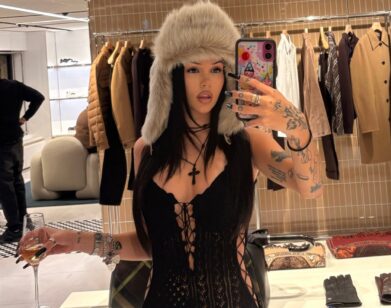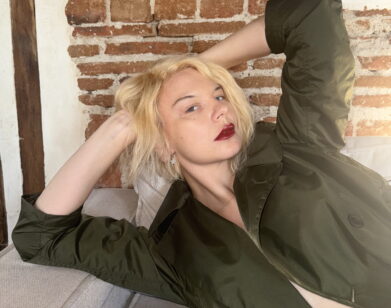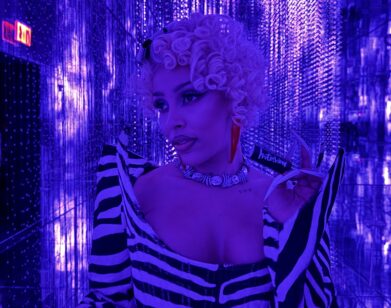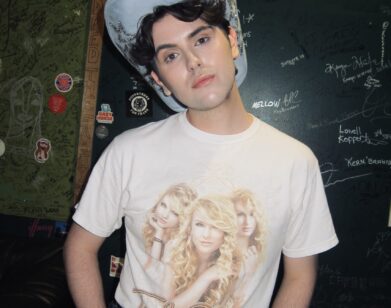Sight and Sound: The Divine Dev Hynes
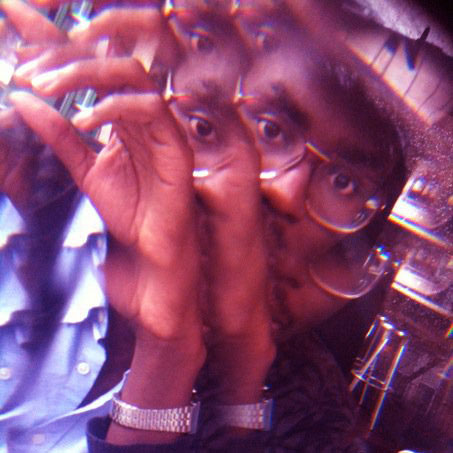
SELF-PORTRAIT BY DEV HYNES
Dev Hynes is a man of many beautiful faces. Having spent the past three years making orchestral pop under the moniker Lightspeed Champion, and releasing two albums on Domino, Hynes is now laying Lightspeed to rest in favor of his new musical project, Blood Orange. Combining early ’80s disco with beautiful eastern melodies, put simply, Blood Orange is pure sex. A British expatriate in NYC, Hynes also works as a songwriter and producer, writing for artists like Florence and the Machine and Chemical Brothers, and producing hip-hop artist Theophilis London and UK popstress Diana Vickers. Most recently, he’s produced and written on the forthcoming third album from Solange Knowles, and worked with Rewards’ Aaron Pfenning. Ever the polymath, Hynes’ newest venture is as a consultant for Rocawear, Jay-Z and Damon Dash’s clothing line.
What many people don’t know about Hynes, however, is that he has synesthesia, a neurological condition in which one sense is simultaneously perceived by one or more additional senses. In Hynes’ case, his sight and audition senses are linked, causing him to literally see sounds. He describes his experience as viewing moving pictures, with tone, pitch, instrument, the spoken voice, and volume all having their own separate color qualities. What a freak!
KARLEY SCIORTINO: You have a history of ditching musical projects after just a few years–first it was your band Test Icicles, now Lightspeed Champion. Why is that?
DEV HYNES: I’m always weary of connotations. I don’t want people to listen to the music I make presently because they liked my previous work, or to dismiss it because they didn’t. I’m guilty of this as well—having preconceptions about other artists—but it’s stupid because all music exists on its own and should be listened to with a clear head. That’s what I’m hoping to achieve by giving different names to each new project I begin.
SCIORTINO: You mentioned that Blood Orange is the first time you’ve used your synesthesia as a tool in the song writing process. How so?
HYNES: If you think about it, there are certain color combinations that are universally recognized as being pleasing to the eye. With Blood Orange, I thought it would be interesting to try and write music which produced the most visually attractive color patterns for me, curious to see if other people would react to the music in a similar way. It got very detailed and I became obsessive at a certain point, but it also made the songwriting process a lot of fun.
SCIORTINO: Is your synesthesia ever a hindrance in daily life?
HYNES: It used to be really distracting. It was difficult to hang out in bars or at gigs and speak to people, because with all the different noises it becomes total insanity. But I’ve learned to get over it, to focus.
SCIORTINO: Your Blood Orange songs are so sexy. Have you ever thought about using your synesthesia to document the color patterns people make during sex, and then use those color patterns to write songs?
HYNES: Uh… it’s a good concept, but I think it would probably sound like weird garbage. I don’t predict people would want to listen to it.
SCIORTINO: What would you say are the main musical influences on Blood Orange?
HYNES: F.R. David is a huge influence—a French singer who got big in the early 80s. I took a lot from his vocal style, or stole it, depending on how you look at it. Also Rick Derringer-era Cyndi Lauper, and a lot of early 80’s pop.
SCIORTINO: Can you give us some hints about what the Solange Knowles album will sound like?
HYNES: I think people will see the link between the Solange record and Blood Orange. We’re both very much in the same head space musically. It’s very Janet Jackson, Earth Wind & Fire, SOS Band. It’s fucking cool, basically. We’ve been writing and recording for the past eight months. It’s probably the most I’ve ever worked on a music project in my life. I don’t work this hard on my own records.
SCIORTINO: In your artwork for Blood Orange, you use lots of images of famous ’80s transsexuals.
HYNES: I find New York, early 80s gay culture so amazing—the ball culture, what they created, how they expressed themselves. I admire them endlessly for their bravery. I can’t even imagine how difficult it was to be young, black, and gay 30 years ago. When I was younger growing up in Essex—a small town in England—I dressed pretty weird, and a lot of my friends were gay, so I essentially grew up as a gay kid even though I was straight. I had all the abuse—was spat on daily, called a fag, was pushed around. The whole aesthetic of Blood Orange is basically a celebration of gay culture. I want to celebrate people who I feel represent freedom, for example Octavia St. Laurent, who I’ve done a little tribute to on the Myspace.
SCIORTINO: Is there any connection between your love of trannies and the fact that you totally sound like a woman when you sing?
HYNES: You think so? Thanks! I’ve been trying to make my voice sound as androgynous as possible. When writing the album, I was trying to write songs that could be sung by a drag queen. The song “Sutphin Boulevard” is about a young boy who dresses in drag, then at night sneaks out to party. Most of the songs are about yearning, wanting something better, escapism, most with a happy ending.
BLOOD ORANGE’S DEBUT SINGLE, “DINNER,” COMES OUT IN JANUARY ON TERRIBLE RECORDS, FOLLOWED BY A FULL-LENGTH ON DOMINO IN EARLY 2011. FIND OUT MORE ABOUT BLOOD ORANGE HERE.

